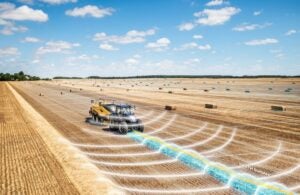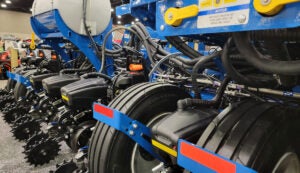This article could have been written by artificial intelligence, but thankfully, it wasn’t. But that doesn’t mean that lots of other niches in the ag industry aren’t employing AI to hone their technical prowess and do things that were almost unimaginable a few years ago.
Companies are using artificial intelligence to map out fertilizer, pest, and weed control spray treatments. Others are combining it with sensor technology and data analytics to enhance the capabilities of milking robots. Still elsewhere, researchers can harness AI and computational biology to select plants with desirable traits, such as drought resistance, and develop them at faster rates and without the regulatory concerns that come with genetically engineered varieties.
“The seed has potential, the ground has potential, Mother Nature’s going to mess with it,” said Zac Spence, product manager at Trimble. “You really want the best opportunity to turn that seed, that highly expensive thing into ROI, into opportunity.”
That’s where he — and several others in the industry — see artificial intelligence steering us.
At the 2024 National Farm Machinery Show, companies rooted in ag tech talked about how AI is involved in some of the latest things they are working on (at least as they were able to discuss within the bounds of proprietary information and competitive advantages).

Most companies today are trying to step beyond the algorithm-processing capabilities of AI; sifting through big data and identifying trends has long been done for things such as fertilizer applications and soil layers. The next advancement is to give these machines the opportunity to learn so they can, in turn, help operators with precision approaches to field management.
In one example, “where we’re seeing some progression is in smart sprays,” Spence noted. He said camera-based technology captures vital imagery and should, in the future, allow the software to identify areas of concern, such as a thistle problem, and then automatically change the tank mix. It doesn’t just see; it also interprets.
“It should help us on the fly make decisions closer to the operation,” he said.
Right now, in agriculture, there’s a lot of aftermath work being done — much more reactionary than proactive. Artificial intelligence should get this industry to a stage where adjustments can be made almost immediately instead of having to wait weeks or months to choose an approach.
“If we can make adjustments and decisions that much closer to the operation, that’s real value,” Spence said.
Syngenta’s whole-farm Cropwise platform includes crop protection, seed care, and farm management software such as financials, imagery, and a scouting program.
“We’re trying to digitize AI to bring it into focus with the digital offerings that we offer growers,” said a Cropwise representative at the National Farm Machinery Show.
He said one young Cropwise project encapsulates both machine learning and enhanced processing functions to address nematodes.
“Using AI to drive those algorithms for us can really free up time and allow growers to make more timely decisions,” he said.

In machinery, Kinze said that the next evolutionary step with artificial intelligence is taking real-time data as you’re driving through the field and having it make decisions based on moisture, population, and soil temperature automatically. This kind of work will allow operators to set their preferred population, fertilizer level, vacuum level, or bulk-fill level, and the planters automatically adjust to hit those marks based on hydraulic oil temperatures, how fast the machine is moving, or how the PTO is running.
“Tell us what you want to do, and we’ll do it for you,” said one Kinze expert. “It’s all about utilizing closed-loop controls.”
As labor gets more scarce in agriculture, AI tools such as these will make it easier to be more versatile with how sits in the tractor seat.
Spence from Trimble said that a lot is happening already today. Still, he sees a positive future, especially as AI adapts to making better field recommendations for farmers.
“You can’t have a $750,000 machine sitting in the corner of the field, saying, ‘I don’t know what to do next, so I’m just going to sit here so I don’t hurt anything,’ You can’t do that,” he said. “It’s got to be able to be smart and to say, ‘How do I get out of it.'”
Ryan Tipps is the founder and managing editor of AGDAILY. He has covered farming since 2011, and his writing has been honored by state- and national-level agricultural organizations.



